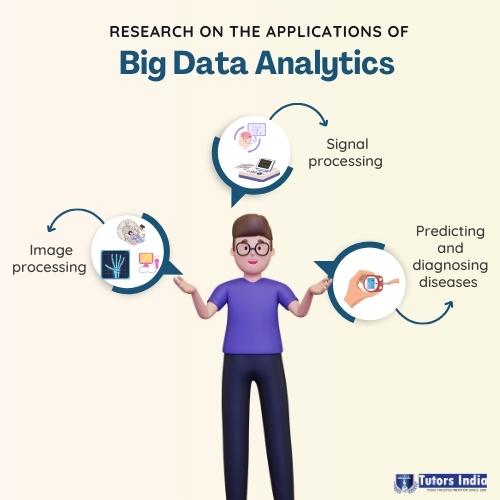Future Research Direction of Big Data Analytics in Healthcare: 2023-2024
What is Big Data?
- The term ‘Big Data’ was used for the first time in the mid-1990s by John Mashey, former Chief Scientist at Silicon Graphics. Big Data refers to handling and analysing extensive datasets.
Big Data is characterised by the following 3 ‘Vs’:
- Volume: which refers to the extensive quantities of data,
- Velocity: which refers to creating data in real-time, and
- Variety: Big Data can be structured, semi-structured and unstructured (Kitchin, 2016).
What is Big Data Analytics?
- Big Data Analytics (BDA) is a type of advanced analytics involving applications such as statistical algorithms and predictive models powered by analytics systems.
- Big Data Analytics (BDA) is the process of analysing Big Data to obtain important information like associations, market trends and consumer preferences, facilitating data-driven and evidence-based decision-making.
- The use of BDA has become popular in multiple disciplines like business, healthcare, engineering and finance (Nguyen, 2018).
Big Data Analytics in Healthcare
- Big Data and Big Data Analytics have gained significant interest in the healthcare sector since it is a complex system with multiple stakeholders such as health insurers, government agencies and researchers.
- The field of healthcare has begun to adapt to the digital data age. Novel technologies like Big Data have enabled capturing information about individual patients over a longer time. Electronic Health Records (EHRs) can be considered an ideal example of Big Data in healthcare.
The available research on the applications of Big Data Analytics in medicine and healthcare are as follows:

1.Image Processing:
Medical images are valuable sources of data that are commonly used for diagnosis, therapy evaluation and planning. Examples of medical images include X-rays, Computed Tomography (CT), Magnetic Resonance Imaging (MRI), ultrasound, molecular imaging and mammography. The size of medical image data can range from a few megabytes for a single study (e.g. histology images) to hundreds of megabytes per study (g. Computed Tomography studies that use more than 2500 scans per study). Big Data Analytics helps in storing such massive amounts of data, which subsequently assist healthcare professionals in the diagnosis, treatment and prognosis of a condition.
2.Signal Processing:
Signal Processing, also called biomedical signal processing, deals with obtaining and preprocessing physiological signals and drawing inferences to identify patterns and trends within the signals. Examples of biomedical signals include cardiac rhythm, muscle movement and neural activity, and examples of signal processing in healthcare include Electrocardiogram (ECG), Electroencephalogram (EEG) and Electromyography (EMG). Like medical images, signals pose challenges, especially while acquiring high-resolution signals and storage from multiple monitors connected to the same patient. This calls for research on the application of Big Data Analytics in signal processing, which will enable storing massive amounts of data (Belle, 2015).
3.Predicting and diagnosing diseases:
There has been research on incorporating Big Data Analytics in the personalised detection of diabetes in the form of smart clothing. Big Data Analytics can also be used in molecular profiling. EHR data and molecular data can be used for predicting diseases. When Machine learning algorithms like Support Vector Machine (SVM) and Convolutional Neural Network (CNN) are incorporated, Big Data Analytics can help detect lung cancer and breast cancer (Saranya, 2019).
Future Research Directions for Big Data Analytics in Healthcare
- Research can be done on the “Prediction of outbreaks and identification of the causes and the pattern of spread of infectious diseases”. A systematic review of the application of Big Data Analytics for COVID-19 revealed that using Big Data Analytics can help detect and forecast COVID-19 manifestations (Tenali, 2023).
- While research has shown that Big Data Analytics significantly improves the functioning of healthcare organisations, research could be conducted on the “Integration and standardisation of medical devices that could improve the performance of healthcare organisations” (Cozzoli, 2022).
- One challenge of using Big Data Analytics in Healthcare is the propensity to disclose sensitive information. Research could be done on “Improving the security and privacy of patient information”.
- Research on “Developing cost-effective solutions for the incorporation of Big Data in healthcare”.
- Research on “Improving the regulatory framework for Big Data Analytics in healthcare”, for Big Data in healthcare is not yet standardised (Wazid, 2022).
Conclusion
Big Data refers to handling and analysing huge amounts of data and is characterised by volume, variety and velocity. An advanced type of analytics for analysing Big Data is known as Big Data Analytics. Big Data Analytics is helpful for predicting market trends and consumer behaviour. Big Data and Big Data Analytics have gained considerable interest in the healthcare sector, where they can be used for predicting diseases, image processing and signal processing. Future research on Big Data Analytics involves research on protecting the security of patient information, making the incorporation of Big Data more cost-effective, improving the regulatory framework, standardisation and integration of medical devices and predicting outbreaks and identifying the causes and spread of infectious diseases.
About Tutors India
We are a team of professional academic writers, statisticians and researchers from recognised universities who assist Master’s students with dissertations. We understand that students often face challenges with dissertation statistical analysis. Therefore, we offer comprehensive solutions that help them analyse data and draw meaningful conclusions, which is crucial for their dissertation. In addition, we also offer study guides and examples that help Master’s students write their dissertations with confidence.
To know more about how statistical analysis is conducted, check out our statistical analysis examples.
References
- Kitchin, R., & McArdle, G. (2016). What makes Big Data, Big Data? Exploring the ontological characteristics of 26 datasets. Big Data & Society, 3(1).
- Truong Nguyen, Li ZHOU, Virginia Spiegler, Petros Ieromonachou, Yong Lin, Big Data Analytics in supply chain management: A state-of-the-art literature review, Computers & Operations Research, Volume 98,2018, Pages 254-264. .
- Belle, A., Thiagarajan, R., Soroushmehr, S. M., Navidi, F., Beard, D. A., & Najarian, K. (2015). Big Data Analytics in healthcare. BioMed research international, 2015.
- Saranya and P. Asha, “Survey on Big Data Analytics in Health Care,” 2019 International Conference on Smart Systems and Inventive Technology (ICSSIT), Tirunelveli, India, 2019, pp. 46-51.
- Tenali, N., Babu, G.R.M. A Systematic Literature Review and Future Perspectives for Handling Big Data Analytics in COVID-19 Diagnosis. New Gener. Comput. 41, 243–280 (2023).
- Cozzoli, N., Salvatore, F.P., Faccilongo, N. et al. How can Big Data Analytics be used for healthcare organization management? Literary framework and future research from a systematic review. BMC Health Serv Res 22, 809 (2022).
- Wazid, M., Das, A. K., Mohd, N., & Park, Y. (2022). Healthcare 5.0 security framework: applications, issues and future research directions. IEEE Access. https://doi.org/ 1109/ACCESS.2022.3228505

 Previous Post
Previous Post